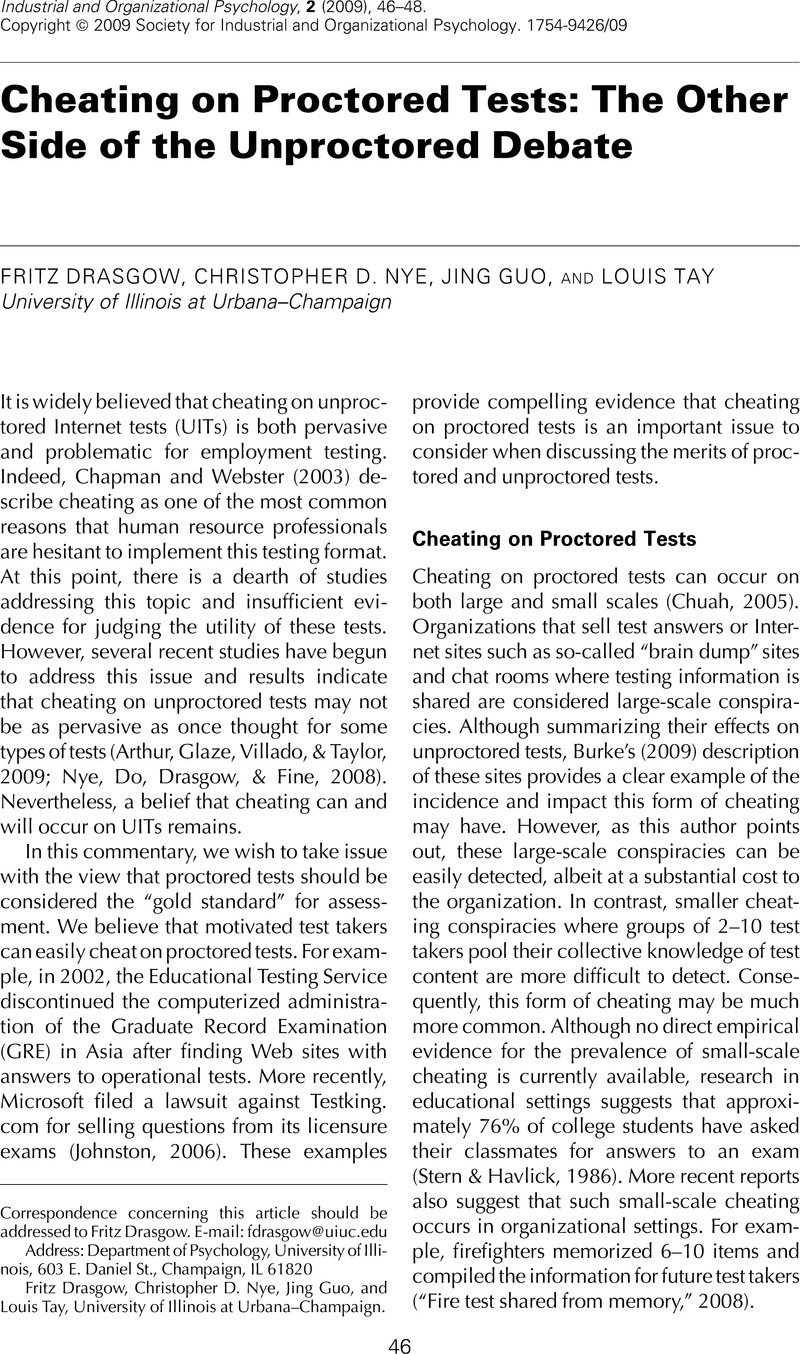Crossref Citations
This article has been cited by the following publications. This list is generated based on data provided by Crossref.
Beaty, James C.
Dawson, Craig R.
Fallaw, Sarah S.
and
Kantrowitz, Tracy M.
2009.
Recovering the Scientist–Practitioner Model: How IOs Should Respond to Unproctored Internet Testing.
Industrial and Organizational Psychology,
Vol. 2,
Issue. 1,
p.
58.
Tippins, Nancy T.
2009.
Where Is the Unproctored Internet Testing Train Headed Now?.
Industrial and Organizational Psychology,
Vol. 2,
Issue. 1,
p.
69.
Guo, Jing
and
Drasgow, Fritz
2010.
Identifying Cheating on Unproctored Internet Tests: The Z‐test and the likelihood ratio test.
International Journal of Selection and Assessment,
Vol. 18,
Issue. 4,
p.
351.
Arthur, Winfred
and
Glaze, Ryan M.
2011.
Technology‐Enhanced Assessment of Talent.
p.
99.
Burke, Eugene
Mahoney‐Phillips, John
Bowler, Wendy
and
Downey, Kate
2011.
Technology‐Enhanced Assessment of Talent.
p.
355.
Beaty, James C.
Nye, Christopher D.
Borneman, Matthew J.
Kantrowitz, Tracy M.
Drasgow, Fritz
and
Grauer, Eyal
2011.
Proctored Versus Unproctored Internet Tests: Are unproctored noncognitive tests as predictive of job performance?.
International Journal of Selection and Assessment,
Vol. 19,
Issue. 1,
p.
1.
Landers, Richard N.
and
Sackett, Paul R.
2012.
Offsetting Performance Losses Due to Cheating in Unproctored Internet‐based Testing by Increasing the Applicant Pool.
International Journal of Selection and Assessment,
Vol. 20,
Issue. 2,
p.
220.
Chen, Hsiang-Yang
and
Chuang, Chao-Hua
2012.
The learning effectiveness of nursing students using online testing as an assistant tool: A cluster randomized controlled trial.
Nurse Education Today,
Vol. 32,
Issue. 3,
p.
208.
Stone, Dianna L.
Lukaszewski, Kimberly M.
Stone-Romero, Eugene F.
and
Johnson, Teresa L.
2013.
Factors affecting the effectiveness and acceptance of electronic selection systems.
Human Resource Management Review,
Vol. 23,
Issue. 1,
p.
50.
Karim, Michael N.
Kaminsky, Samuel E.
and
Behrend, Tara S.
2014.
Cheating, Reactions, and Performance in Remotely Proctored Testing: An Exploratory Experimental Study.
Journal of Business and Psychology,
Vol. 29,
Issue. 4,
p.
555.
Kantrowitz, Tracy M.
and
Dainis, Amanda M.
2014.
How Secure are Unproctored Pre-Employment Tests? Analysis of Inconsistent Test Scores.
Journal of Business and Psychology,
Vol. 29,
Issue. 4,
p.
605.
Tippins, Nancy T.
2015.
Technology and Assessment in Selection.
Annual Review of Organizational Psychology and Organizational Behavior,
Vol. 2,
Issue. 1,
p.
551.
Dickter, David N.
Jockin, Victor
and
Delany, Tanya
2017.
The Wiley Blackwell Handbook of the Psychology of the Internet at Work.
p.
257.
Nye, Christopher D.
and
Ryan, Ann Marie
2023.
Improving Graduate-School Admissions by Expanding Rather Than Eliminating Predictors.
Perspectives on Psychological Science,
Vol. 18,
Issue. 1,
p.
54.





